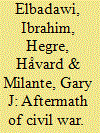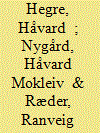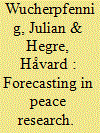|
|
|
Sort Order |
|
|
|
Items / Page
|
|
|
|
|
|
|
| Srl | Item |
| 1 |
ID:
083244


|
|
|
|
|
| Publication |
2008.
|
| Summary/Abstract |
This article introduces the special issue on `The Aftermath of Civil War' and presents the research project from which the articles in this issue originate. The article presents a few empirical observations that demonstrate the increasing importance of the post-conflict situation for actors that engage to reduce the global incidence of armed conflict. The global incidence of conflict was reduced from 1992 to 2002, since there were more terminations than onsets. Although this trend seems to have halted, a scrutiny of the onsets shows that they increasingly are recurrences of conflicts that have been inactive for a period. In 2005 and 2006, there were no new conflicts. The article then briefly introduces the six contributions to the special issue. The articles investigate the importance of peacekeeping troops, elections, aid, capital flight, and exclusion of parties from peace agreements in post-conflict situations. The articles are also applicable to countries that have not had armed conflicts, as the authors investigate the relationship between ethnic diversity and military spending and the determinants of youths' decisions to participate in rebel groups.
|
|
|
|
|
|
|
|
|
|
|
|
|
|
|
|
| 2 |
ID:
152301


|
|
|
|
|
| Summary/Abstract |
Several studies show that internal armed conflict breeds conflict by exacerbating conditions that increase the chances of war breaking out again. Empirically, this ‘conflict trap’ works through four pathways: conflicts increase the likelihood of continuation, recurrence, escalation, and diffusion of conflict. Past empirical studies have underestimated the scope and intensity of the conflict trap since they consider the impact of conflict only through one of these pathways and rarely across sufficiently long time periods. This article shows that simulation and forecasting techniques are useful and indeed necessary to quantify the total, aggregated effect of the conflict trap, over long time periods and across countries. We develop a country-year statistical model that allows estimating the probability of no conflict, minor conflict, and major conflict, and the probabilities of transition between these states. A set of variables denoting the immediate and more distant conflict history of the country are used as endogenous predictors in the simulated forecasts. Another set of variables shown to be robustly associated with armed conflict are treated as exogenous predictors. We show that the conflict trap is even more severe than earlier studies have indicated. For instance, if a large low-income country with no previous conflicts is simulated to have two to three years of conflict over the 2015–18 period, we find that it will have nine more years of conflict over the 2019–40 period than if peace holds up to 2018. Conversely, if a large low-income country that has had major conflict with more than 1,000 battle-related deaths in several of the past ten years succeeds in containing violence to minor conflict over the 2015–18 period, we find that it will experience five fewer years of conflict in the subsequent 20 years than if violence continues unabated.
|
|
|
|
|
|
|
|
|
|
|
|
|
|
|
|
| 3 |
ID:
152293


|
|
|
|
|
| Summary/Abstract |
Prediction and forecasting have now fully reached peace and conflict research. We define forecasting as predictions about unrealized outcomes given model estimates from realized data, and predictions more generally as the assignment of probability distributions to realized or unrealized outcomes. Increasingly, scholars present within- and out-of-sample prediction results in their publications and sometimes even forecasts for unrealized, future outcomes. The articles in this special issue demonstrate the ability of current approaches to forecast events of interest and contributes to the formulation of best practices for forecasting within peace research. We highlight the role of forecasting for theory evaluation and as a bridge between academics and policymakers, summarize the contributions in the special issue, and provide some thoughts on how research on forecasting in peace research should proceed. We suggest some best practices, noting the importance of theory development, interpretability of models, replicability of results, and data collection.
|
|
|
|
|
|
|
|
|
|
|
|
|
|
|
|
| 4 |
ID:
165446


|
|
|
|
|
| Summary/Abstract |
This article presents ViEWS – a political violence early-warning system that seeks to be maximally transparent, publicly available, and have uniform coverage, and sketches the methodological innovations required to achieve these objectives. ViEWS produces monthly forecasts at the country and subnational level for 36 months into the future and all three UCDP types of organized violence: state-based conflict, non-state conflict, and one-sided violence in Africa. The article presents the methodology and data behind these forecasts, evaluates their predictive performance, provides selected forecasts for October 2018 through October 2021, and indicates future extensions. ViEWS is built as an ensemble of constituent models designed to optimize its predictions. Each of these represents a theme that the conflict research literature suggests is relevant, or implements a specific statistical/machine-learning approach. Current forecasts indicate a persistence of conflict in regions in Africa with a recent history of political violence but also alert to new conflicts such as in Southern Cameroon and Northern Mozambique. The subsequent evaluation additionally shows that ViEWS is able to accurately capture the long-term behavior of established political violence, as well as diffusion processes such as the spread of violence in Cameroon. The performance demonstrated here indicates that ViEWS can be a useful complement to non-public conflict-warning systems, and also serves as a reference against which future improvements can be evaluated.
|
|
|
|
|
|
|
|
|
|
|
|
|
|
|
|
| 5 |
ID:
178734


|
|
|
|
|
| Summary/Abstract |
This article presents an update to the ViEWS political Violence Early-Warning System. This update introduces (1) a new infrastructure for training, evaluating, and weighting models that allows us to more optimally combine constituent models into ensembles, and (2) a number of new forecasting models that contribute to improve overall performance, in particular with respect to effectively classifying high- and low-risk cases. Our improved evaluation procedures allow us to develop models that specialize in either the immediate or the more distant future. We also present a formal, ‘retrospective’ evaluation of how well ViEWS has done since we started publishing our forecasts from July 2018 up to December 2019. Our metrics show that ViEWS is performing well when compared to previous out-of-sample forecasts for the 2015–17 period. Finally, we present our new forecasts for the January 2020–December 2022 period. We continue to predict a near-constant situation of conflict in Nigeria, Somalia, and DRC, but see some signs of decreased risk in Cameroon and Mozambique.
|
|
|
|
|
|
|
|
|
|
|
|
|
|
|
|
|
|
|
|
|